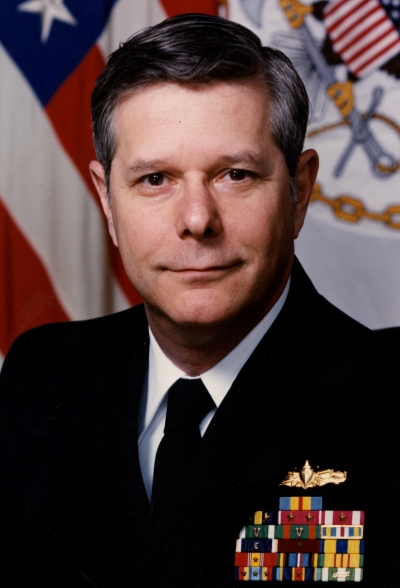Admiral Jeremy M. Boorda
Twenty-fifth Chief of Naval Operations
April 23, 1994–May 16, 1996
Admiral Jeremy “Mike” Boorda, known as a “Sailor’s Sailor,” was the first surface warrior to hold the office since Admiral Elmo Zumwalt and the first enlisted Sailor to rise continuously from the ranks to become Chief of Naval Operations. Within a year, he had promulgated “Forward . . . . From the Sea,” which emphasized a post-Cold War Navy focused on combat-credible forward presence that would be borne out consistently in operations. Experienced in manpower and personnel areas, he managed the largest mandated reduction in naval personnel since World War II with sensitivity and careful priorities while driving Navy modernization with the F/A-18E/F Super Hornet aircraft, a new attack submarine, Surface Combatant 21, and theater ballistic missile defense.
Forward presence as a central U.S. Navy tenet was the premise in “Forward . . . . From the Sea” and the primary driver in the Navy’s budget while Admiral Boorda was Chief of Naval Operations. It also included justification for the twelfth carrier requirement. Preventing conflict and emphasizing joint and combined exercises and operations were also significant aspects of the new strategic construct. The ability to put two carrier battle groups off Taiwan in 1996 during People’s Republic of China missile tests and have a third move from the Mediterranean to the Persian Gulf at the same time was a powerful proof of concept.
Admiral Boorda became Chief of Naval Operations after a relatively bumpy period of negative publicity for the Navy—from Tailhook to a cheating scandal at the U.S. Naval Academy to an accidental firing on a Turkish destroyer—and he worked hard at returning a sense of pride to those serving. His predecessor, Admiral Frank Kelso, had instituted the “Sailor’s Creed” for all enlisted to memorize at boot camp. Admiral Boorda replaced the word “bluejacket” with “Navy” to include all hands in this unifying effort, emphasizing that Navy personnel are Sailors first and their ranks second.
Much like Admiral Zumwalt, Admiral Boorda focused his energies on improving the quality of life for all Sailors. He was well known for ignoring concerns about setting precedents that could not be maintained, emphasizing instead the need to do the right thing for individual Sailors. His tenure saw the first women deploy in combat air squadrons on carriers and reporting to surface combatants following the repeal of the Combat Exclusion Law in 1994.
It was while he was CNO that the Blue Angels named their first African-American commanding officer, and the first African-American admiral, J. Paul Reason, achieved four-star rank. Admiral Boorda also reinstituted a program known as “Seaman to Admiral” to provide Sailors the same promotional opportunity he had.
Jeremy Michael Boorda was born in South Bend, Indiana, on November 26, 1939, and enlisted in the U.S. Navy in 1956. On his way to the rank of petty officer first class, he served primarily in aviation. He was selected for commissioning under the Integration Program and, after attending Officer Candidate School in Newport, Rhode Island, was commissioned in August 1962.
During his 34 years of commissioned service, he served at sea in destroyers USS Porterfield and USS John R. Craig. He was executive officer of USS Brooke and commanded USS Parrot, USS Farragut, and Destroyer Squadron 22. Afloat tours as a flag officer included Commander, Cruiser-Destroyer Group Eight in Norfolk, Virginia; Carrier Battle Group Commander embarked in USS Saratoga; and Commander, Battle Force Sixth Fleet.
Ashore, he was a weapons instructor at Naval Destroyer School in Newport, attended the U.S. Naval War College, and earned a bachelor of arts degree from the University of Rhode Island. His first tour in manpower and personnel came as Head, Surface Lieutenant Commander Assignments/Assistant for Captain Detailing in the Bureau of Naval Personnel. Relieving a civilian presidential appointee, he was assigned as Executive Assistant to the Principal Deputy Assistant Secretary of the Navy for Manpower and Reserve Affairs, Washington, DC.
He served as Executive Assistant to the Chief of Naval Personnel/Deputy Chief of Naval Operations for Manpower, Personnel, and Training. In December 1984 he assumed his first flag officer assignment as Executive Assistant to Chief of Naval Operations Admiral James Watkins. In August 1988 Admiral Boorda became Chief of Naval Personnel/Deputy Chief of Naval Operations for Manpower, Personnel, and Training.
Receiving his fourth star in November 1991, he reported as Commander in Chief, Allied Forces Southern Europe (CINCSOUTH) and Commander in Chief, U.S. Naval Forces, Europe in December. As CINCSOUTH, Admiral Boorda was in command of all NATO forces engaged in operations enforcing United Nations sanctions against the warring factions in the former Republic of Yugoslavia and ordered the first offensive action in NATO’s history, the strikes against Bosnian Serb aircraft violating the no-fly zone. On February 1, 1993, Admiral Boorda assumed additional duty as Commander, Joint Task Force Provide Promise, responsible for the supply of humanitarian relief to Bosnia.
Admiral Boorda died May 16, 1996, of a self-inflicted gunshot wound. President William J. Clinton, his Commander in Chief, said of Admiral Boorda at his funeral in the National Cathedral in Washington, DC, “Many have said before me that his lasting legacy will be his concern for the Sailors. He knew the people were the Navy’s greatest asset. And every day he made the Navy stronger because he took good care of its Sailors.”
Explore more, click on the link for the CNO's baseball cards, here
Prepared for CNO and OPNAV Centennial Celebration, May 2015. Visit the Research section for additional information.



